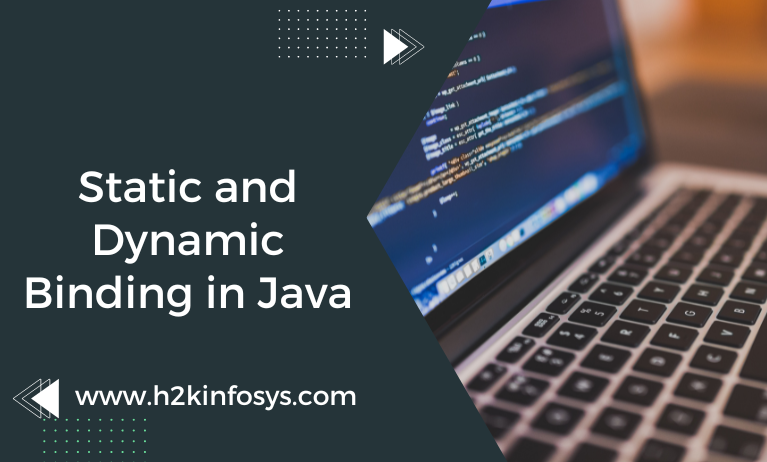One of the most widely used object-oriented programming languages in the world, Java offers a wide range of applications from creating software to creating apps. Given that we have to deal with several methods and their implementations, binding in Java is a crucial topic. Java has both static and dynamic binding functionality. As we continue reading this post, we will learn everything there is to know about static binding and dynamic binding, including examples, benefits, and drawbacks.
Binding refers to the connection between the method call and the method body. The two types of binding are static binding and dynamic binding, both of which take place during runtime. You should learn a few terms before fully understanding static and dynamic binding in Java. That will help you understand the concept better. Binding is the term for the connection between a method definition and method call, as was previously discussed. You can check out the Java full course to learn more about Static and Dynamic binding.
In Java, binding and polymorphism are closely related concepts that describe the ability of objects of different classes to be treated as though they were objects of the same type. Polymorphism is achieved by inheritance and method overriding, which allow a subclass to provide a unique implementation of a method that is already defined in its superclass. The kind of reference variable used to call the function will determine whether static or dynamic binding is employed.
Static Binding or Early Binding
Static or early binding is defined as a binding that the compiler can resolve at compile time. Static, private, and final method binding occurs at compile time. Why? The reason is that the class’s type is determined at compile time and that these methods cannot be overridden.
Dynamic Binding or Late Binding Java
Such binding is characterized as dynamic or late binding when the compiler is unable to resolve the call or binding at build time. Method Overriding is a prime example of dynamic binding since it allows for the execution of the same method in both parent and child classes, depending on the object’s type. Dynamic binding is used when the type of an object is determined at runtime.
Since the compiler only considers variable references and not the type of an object, it is unable to determine which version of print should be called during compilation. As a result, binding would have to wait until runtime, when the appropriate version of print would be called based on the type of the object.
Before moving on to explore and implement static and dynamic bindings in Java, where we shall later conclude the differences, there are several crucial elements that need to be recalled.
- While virtual methods (Java methods are virtual by default) are bound at run time depending on the run time object, private, final, and static members (methods and variables) employ static binding.
- While dynamic binding resolves to bind using objects, static binding employs type information to do so.
- While overridden methods use dynamic binding, which occurs at run time, overloaded methods use static binding to resolve (choose which method to call when there are numerous methods with the same name).
Static Binding vs Dynamic Binding Java
Let’s talk about the differences between Java’s static and dynamic binding.
- Dynamic binding occurs at runtime, which means it occurs at runtime and is referred to as late binding. Static binding occurs at compile-time, which means it occurs at compile time for which it is referred to as early binding.
- Since these methods cannot be overridden, the binding of private, static, and final methods always takes place at the moment of compilation. The resolution of such binding occurs at runtime when method overriding is actually occurring and the reference of the parent type is assigned to the object of the child class type.
- Overloaded methods’ bindings are static, but overridden methods’ bindings are dynamic.
- While dynamic binding employs overriding methods, static binding uses operator overloading, which is more precise.
- Normal functions are used for static binding, while virtual functions are used for dynamic binding.
- Real objects are used in static binding, const binding, private binding, and dynamic binding.
Why is binding of static, final and private methods always static binding?
Performance-wise, static binding is superior (no additional overhead is needed). The compiler is aware that all such methods are static and can only ever be called by objects of the local class. As a result, the compiler has no trouble identifying class objects (local classes, for sure). Because of this, binding for these methods is static.
Another justification is that static method binding offers superior performance over runtime binding. As soon as the compiler learns about these methods, it recognizes that they exclude method overriding.
Only the object of the local class has access to these methods. As a result, these methods are always bound during compilation.
Conclusion
In conclusion, static binding is used for private, final, and static members (methods and variables), whereas run-time binding is used for virtual methods (Java methods are virtual by default). While dynamic binding uses objects to resolve binding, static binding employs type information. Finally, static binding is used to resolve overloaded methods (choose which method to call when there are numerous methods with the same name), whereas dynamic binding, or binding at runtime, is used for overridden methods. Check out the Java training to learn more.





























